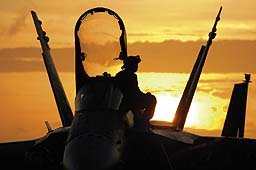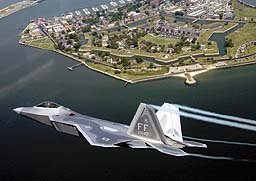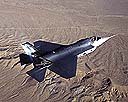With the result of the US Quadrennial Defence Review (QDR) expected to emerge over the coming weeks and months, programme officials in industry and the services, in public and in private, have been repeating the mantra “healthy programmes are safe programmes”. But with US defence spending under unprecedented internal and external pressure, how healthy does a programme have to be to survive, and are any programmes really safe?

As the US Department of Defense prepares to begin internal briefings on the results of the QDR, attention is focused on the Lockheed Martin F/A-22 Raptor andF-35 Joint Strike Fighter (JSF), and to a lesser extend Boeing’s F/A-18E/F Super Hornet, in the belief that the long-awaited tactical aircraft trainwreck is approaching rapidly down the rails.
In more traditional times of high US defence spending, all three programmes would be fairly secure. The F/A-18E/F is half-way through its production run, the F/A-22 is about to enter service and, from a historical viewpoint, the F-35’s development difficulties look normal for such a complex programme. But these are not traditional times. The US defence budget is under immense internal pressure from escalating programme costs and spending on operations in Afghanistan and Iraq, and enormous external pressure from the government’s need to balance its budget.
Effective Raptor
The DoD leadership’s decision to terminate procurement of the F/A-22 after fiscal year 2008, reducing production from 275 aircraft to fewer than 180, was taken just as the stealth fighter came good after years of development difficulties and delays. After 19 years of development, with avionics stability problems behind it, the Raptor emerged from initial operational testing earlier this year having been rated “overwhelmingly effective” by air force testers, but with lingering supportability issues.
 Follow-on operational testing now under way is evaluating fixes introduced to meet the required 85% mission-capable rate, as well as expanding the F/A-22’s weapons capability to include supersonic release of the JDAM precision-guided bomb. Air Combat Command is still expected to declare initial operational capability (IOC) in December, with a squadron of F/A-22s based at Langley AFB, Virginia. But this rapid, if belated, progress may not be sufficient to save the Raptor.
Follow-on operational testing now under way is evaluating fixes introduced to meet the required 85% mission-capable rate, as well as expanding the F/A-22’s weapons capability to include supersonic release of the JDAM precision-guided bomb. Air Combat Command is still expected to declare initial operational capability (IOC) in December, with a squadron of F/A-22s based at Langley AFB, Virginia. But this rapid, if belated, progress may not be sufficient to save the Raptor.
The US Air Force has long maintained it needs 381 F/A-22s to provide one squadron for each of its 10 “air expeditionary force” packages, but a Congressional cap on programme costs had reduced the number to 277 before the latest cut. The new total of 179 Raptors – of which 83 are already under contract and 50 have been delivered – will yield about 110 combat-coded aircraft, only enough to equip four or five squadrons, calculates the US Government Accountability Office (GAO). This would make the F/A-22 a low-density/high-demand asset, and curtail plans to drive the unit flyaway cost, now $130 million, below $100 million.
Possible threats
Lockheed believes a force of around 250 Raptors would be required to counter a “near-peer” nation like China – one of the threats evaluated by the QDR – that operates advanced fighters in an integrated air-defence environment. “No one else can go in there,” says Larry Lawson, F/A-22 programme general manager. But few analysts expect the Raptor to escape the QDR axe, and the key issue could be how much money the USAF has to modernise the fleet. “It becomes more important to improve the capability if there are only 180 aircraft,” he says.
The USAF has embarked on a spiral upgrade programme to expand the Raptor’s capability beyond its air-dominance role and turn the stealth fighter into a “lethal ISR” (intelligence, surveillance and reconnaissance) platform – “ISR with the ability to do something about the data collected in real time,” says Lawson. This will require hardware changes, including an upgraded radar and expanded datalink.
The capabilities are being developed in a series of spirals and will be implemented in production blocks. Spiral 2, or global strike basic, is under way and will be fielded in Block 20 F/A-22s to be delivered from 2007, adding supersonic JDAM and expanded networking. Spiral 3, or global strike enhanced, is “fairly defined”, says Lawson, and planned for Block 30 F/A-22s to be delivered in 2010, adding synthetic-aperture radar, moving-target indication, Small Diameter Bomb and two-way Link 16.
Further spirals, global strike full in 2013 and enhanced ISR in 2015, would result in a Block 40 “net-centric warfare” F/A-22 with satellite communications, electronic attack capability and new precision weapons. Yet to be defined, these would be funded separately and fall outside the planned production run, which would end in 2011 unless the cut to 179 aircraft is reversed by 2008. Modernisation costs after 2011 have not been defined, but could be $700-750 million a year, says the GAO.
JSF vulnerability
With the heaviest JSF expenditure to begin in 2011, the programme looks the most vulnerable. Again the threat comes as the programme’s initial difficulties appear to have been overcome. The first of 15 development flight-test aircraft is complete, and first flight is planned for the end of August next year. After intense work to reduce airframe weight, Lockheed has received an additional $6.5 billion to cover rebaselining and extension of the system development and demonstration programme by 18 months.
The new schedule calls for IOC of the US Marine Corps’ short take-off and landing (STOVL) F-35B in 2012, followed in 2013 by the US Air Force’s conventional take-off and landing (STOL) F-35A and US Navy’s F-35C carrier variant (CV). The F-35A will be first to fly, but the first aircraft – A1 – does not have the weight-optimised airframe. The first production-representative JSF will be the next to fly, when the first F-35B takes to the air in the fourth quarter of 2007, followed in the first quarter of 2008 by the first optimised F-35A and a year later by the first F-35C.
Production JSF
The CTOL F-35A will also be the first JSF variant to enter production, with an initial batch of five planned to be procured in 2007. The second batch of 18 aircraft will comprise eight CTOL and 10 STOVL, while the CV will be added to the mix with the third low-rate initial production (LRIP) batch of 52 aircraft. Full-rate production of 143 aircraft a year is planned to begin in 2013, with the JSF to enter service with the first international customer, the UK, in 2014 – a delay of two years.
 Mission system functionality will also be phased in to reduce risk. Under the restructured spiral development plan, the first 20 aircraft will be delivered with a Block 0 capability requiring about 1 million lines of software code, says Gary Crowley, Lockheed JSF programme general manager. Block 1 aircraft, with 4.2 million lines of code providing a basic warfighting ability, will be delivered in LRIP 3 and two more blocks, each adding 1 million lines of code, will be required to reach full operational capability.
Mission system functionality will also be phased in to reduce risk. Under the restructured spiral development plan, the first 20 aircraft will be delivered with a Block 0 capability requiring about 1 million lines of software code, says Gary Crowley, Lockheed JSF programme general manager. Block 1 aircraft, with 4.2 million lines of code providing a basic warfighting ability, will be delivered in LRIP 3 and two more blocks, each adding 1 million lines of code, will be required to reach full operational capability.
The USAF requirement for 1,763 JSFs us likely to take the biggest hit. But earlier reports that one of the three versions could be cancelled are now being played down. For the QDR, the JSF programme office was asked to study options including “kill the entire programme, accelerate the entire programme, cut one variant, cut two variants”, says Rear Adm Steve Enewold, programme executive officer.
“I think the navy numbers will stay pretty constant,” says Enewold. The combined USN/USMC requirement was cut by a third in 2002, to 680 aircraft, but the mix of CV and STOVL variants was not defined. How much the USAF numbers to come down could depend on how many – if any – of the STOVL variant the service wants. “We will know the USAF numbers when we get the STOVL numbers,” he says.
STOVL’s unique requirements again appear to be driving the JSF programme, including the need to shave weight from the airframe. The USAF does not have a vertical landing requirement, says Enewold, but could benefit for a rolling vertical landing capability being studied for the UK, which is again re-evaluating its choice of the STOVL variant and looking also at the CV JSF.
The uncertainty created by the QDR comes as Lockheed and the US government work to negotiate a single memorandum of understanding with the international partners for JSF production, sustainment and follow-on development. Any substantial cut in US procurement numbers will increase the F-35’s unit flyaway cost, now in the $45-60 million range, and undermine the affordability pillar on which the programme is based.
Compared with the F/A-22 and F-35, the F/A-18E/F is a mature, stable programme. Almost 250 aircraft have been delivered to the US Navy, and production is continuing at a rate of 42 a year under a 210-aircraft, $8.6 billion second multi-year procurement (MYP) contract awarded in December 2003. Boeing has not met its stated goal of the “$40 million jet”, but the current unit flyaway cost of just under $54 million buys the Block 2 version of the F/-18E/F, with significantly improved sensors and avionics.
“The first block upgrade set the E/F apart from the C/D. Block 2 is a step increase in capability over the early aircraft,” says Chris Chadwick, vice-president for F/A-18 programmes. Changes include advanced mission computer and displays, high-bandwidth Fiber Channel network, ATFLIR targeting pod, MIDS datalink and JHMCS helmet sight. But the biggest enhancement is the Raytheon APG-79 AESA radar, which has three times the range and five times the resolution of the APG-73 in F/A-18C/Ds and early E/Fs.
The Super Hornet started out as upgrade the F/A-18 Hornet, and the enlarged airframe was developed on schedule and within budget for a relatively modest $4.88 billion. But the Block 2 avionics are being implemented incrementally, making it hard to work out the true cost of development. Boeing’s challenge is to maintain and enhance the F/A-18E/F’s capability and relevance as US forces move towards joint network-centric operations (NCO). The company has developed a roadmap of enhancements, called Warfighter 21, intended to allow the Super Hornet to be part of an integrated force that will eventually include the JSF and J-UCAS. “As we developed the Block 2 capability, we could see NCO on the horizon,” says Chadwick. “Rather than wait for the next block upgrade, we created a seven-increment roadmap to spiral net-centric capabilities on to the aircraft. Block 2 has all the hooks needed for future incremental upgrades to give net-centric capability.”
Solid-state recorders
The process begins this year with the introduction of solid-state recorders on new-build aircraft. The recorder will be able to frame-grab target imagery from the ATFLIR or AESA for transmission via Link 16 or digital radio to a forward air controller or other aircraft. Later increments would enhance precision engagement capability by correlating sensor imagery with an on-board database; introduce wideband communications with the MIDS-JTRS software-defined radio; and enable operations with unmanned aircraft.
Boeing and the US Navy have been discussing a third multi-year contract to complete the planned procurement of 460 F/A-18E/Fs and 90 EA-18G electronic-attack variants. Whether these become a target for cuts depends on the JSF’s fate. “They were always planned to be complementary,” says Chadwick, adding: “The Super Hornet is risk mitigator for JSF, leading the way into the net-centric environment.” -
GRAHAM WARWICK/ WASHINGTON DC
Source: Flight International
















